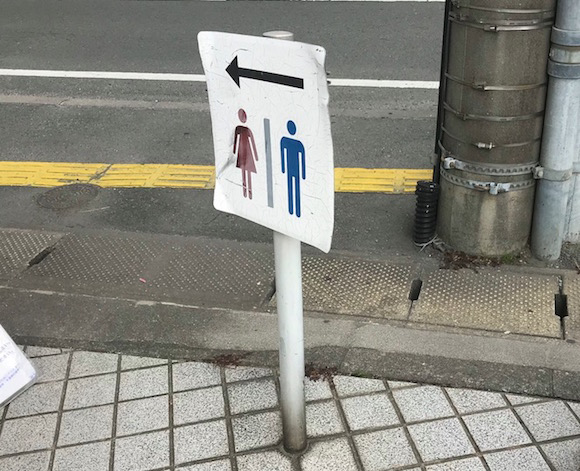
We’re equal parts intrigued and scared as we try this local version of Japan’s favorite noodle dish.
Part of the reason Japan has so many ramen restaurants is because the country has so many different kinds of ramen. The primary way to classify ramen is by the broth, and in addition to soy broth ramen restaurants you can find eateries that specialize in miso, tonkotsu (pork stock), and gyokai (fish stock) ramen.
Sometimes those classes even have their own subcategories. For example, in Fukuoka Prefecture tonkotsu broth is the most prevalent, but individual communities further put their own spin on the dish, which brings us to the town of Omuta, at the south tip of the prefecture, where the locals enjoy something that’s earned the nickname “benjo ramen,” benjo being a coarse Japanese word for “bathroom,” sort of like “the John” or “the head” in English.
The name might have you thinking benjo ramen was developed by convicts who made ramen in their prison cells, or perhaps secretly by people in their homes during some sort of ramen prohibition. The truth, though, is that benjo ramen traces its roots to Omuta’s coal mining boom following the end of World War II. In 1949, a group of four men from Okayama Prefecture came to Omuta and opened a ramen stand next to the town’s main train station. The stand quickly became a popular place for hungry miners to grab a meal, and its legacy is carried on today by the restaurant Kokaen, which makes the same style of ramen and, we’d been told by locals, is the place to go for benjo ramen.
We walked through the door, sat down, and looked at the menu, which simply lists the house noodles as “ramen,” with no “benjo” qualifier. At just 500 yen (US$4.50) it’s pretty cheap for restaurant ramen, although the order of gyoza (pot stickers) we added was also 500 yen, which is surprisingly expensive for the ordinarily inexpensive ramen accompanying side dish.
After a short wait, the waiter set our bowl of “benjo ramen” down in front of us.
As with most ramen in Fukuoka, Kokaen’s ramen has tonkotsu broth. But while tonkotsu broth is often a light tan, or almost milky white color, Kokaen’s, though, is a murky, opaque brown that’s not too far from being gray. It’s also pretty pungent, with an oily aroma, and bubbles of grease on the surface.
But while it might look and smell a little odd, the broth tastes great. As you might expect from a dish originally designed to satisfy off-duty coal miners, it’s incredibly flavorful, with a meaty saltiness. The gyoza reflect a similar philosophy, being packed with so much garlic we’d recommend thinking twice about ordering them if you’re going to be having an important business meeting or hot date following your meal.
▼ 10 gyoza to an order is a lot more than the six that’s the standard at ramen restaurants in Japan, which explains the 500-yen price.
But we still couldn’t understand why Kokaen’s ramen is called “benjo ramen.” Like we said, the menu didn’t offer any hints, and we felt too awkward to ask the staff directly. So we finished our noodles, paid the bill, and walked out of the restaurant, which is when things suddenly became clear.
At the end of the building Kokaen is located in, there’s a public restroom. Because of this, locals have largely stopped referring to the restaurant by its name, and instead just started calling it “benjo yoko ramen,” or “the ramen restaurant next to the restroom.” Eventually, that got shortened down to just “benjo ramen,” and nowadays there are even plenty of taxi drivers in the town who won’t know where you’re talking about if you ask them to drive you to “Kokaen,” but who know exactly where you want to go if you ask for “benjo ramen.”
So don’t fear, there aren’t any public restroom-sourced ingredients going into your benjo ramen (unlike the coffee at that one shady Starbucks in Hong Kong). Really, the bigger thing to worry about is having enough breath mints on you if you do decide to order the gyoza. And if you’re eager to try benjo ramen but want to balance its slightly vulgar name with some classiness elsewhere, you can always ride the fancy new luxury train that goes to Omuta.
Restaurant information
Kokaen / 光華園
Address: Fukuoka-ken, Omuta-shi, Higashi Shinmachi 1-5-15
福岡県大牟田市東新町1−5−15
Open 11 a.m.-12:30 a.m.
Closed Mondays (or Tuesday if Monday is a holiday)
Photos ©SoraNews24
[ Read in Japanese ]